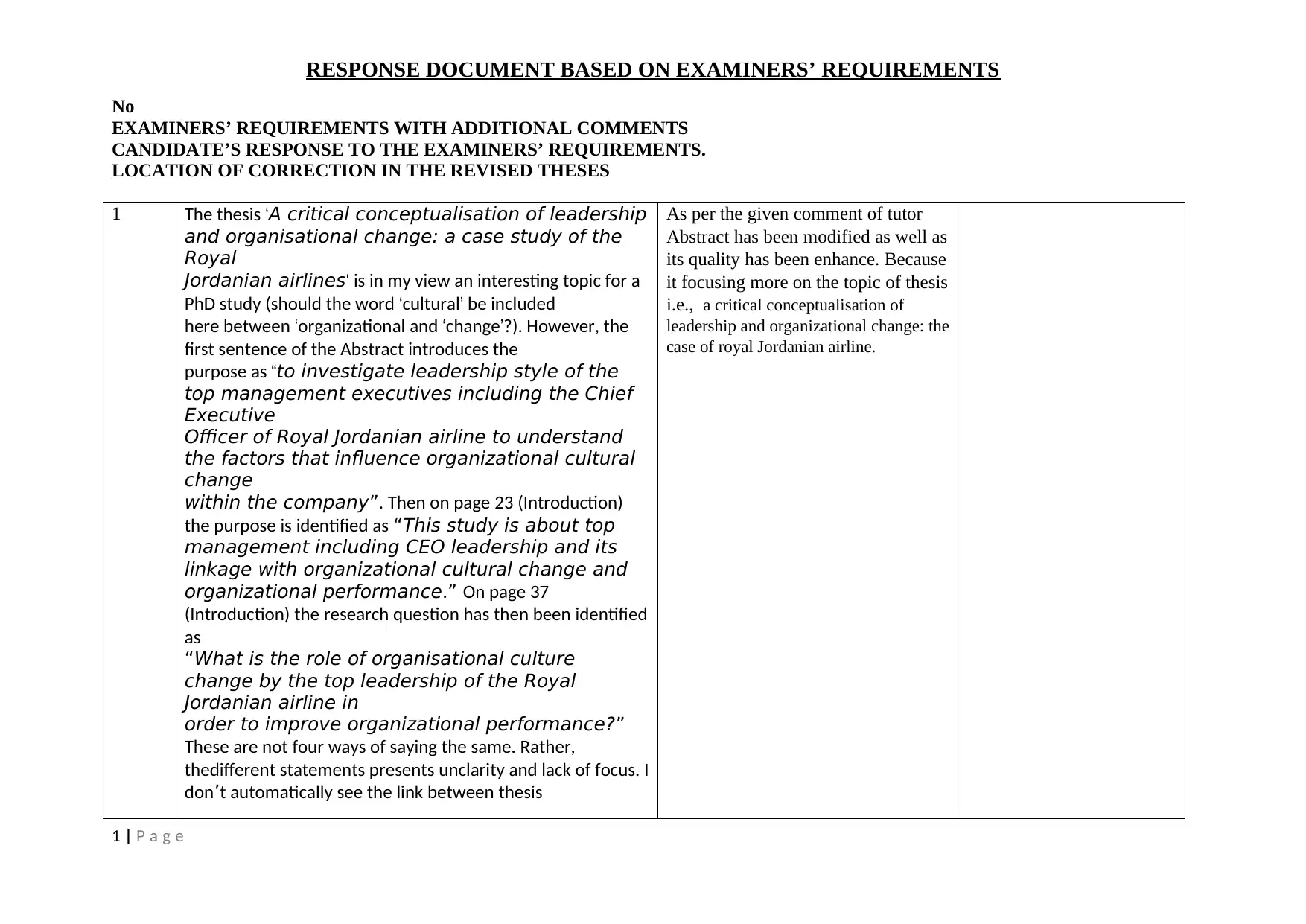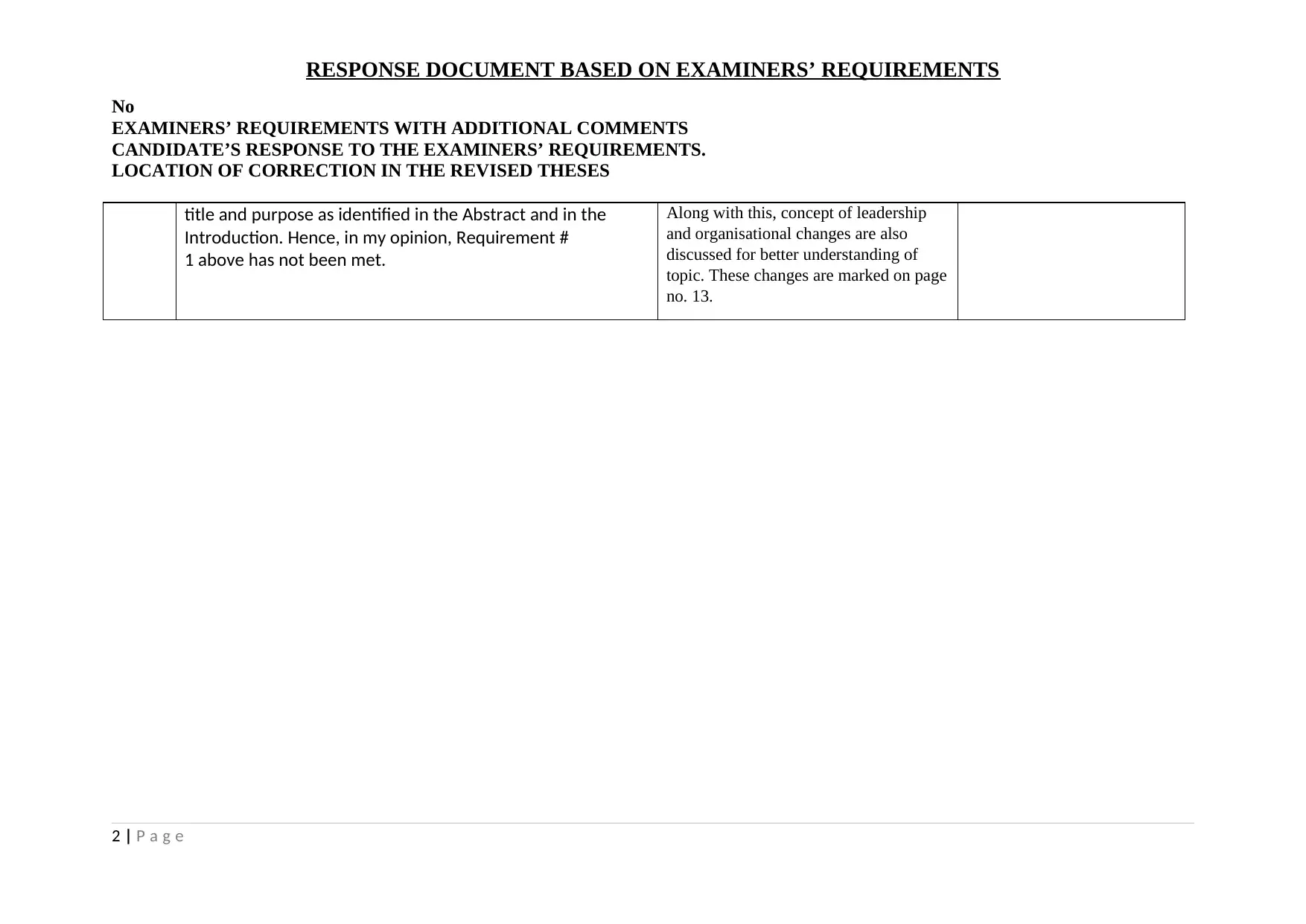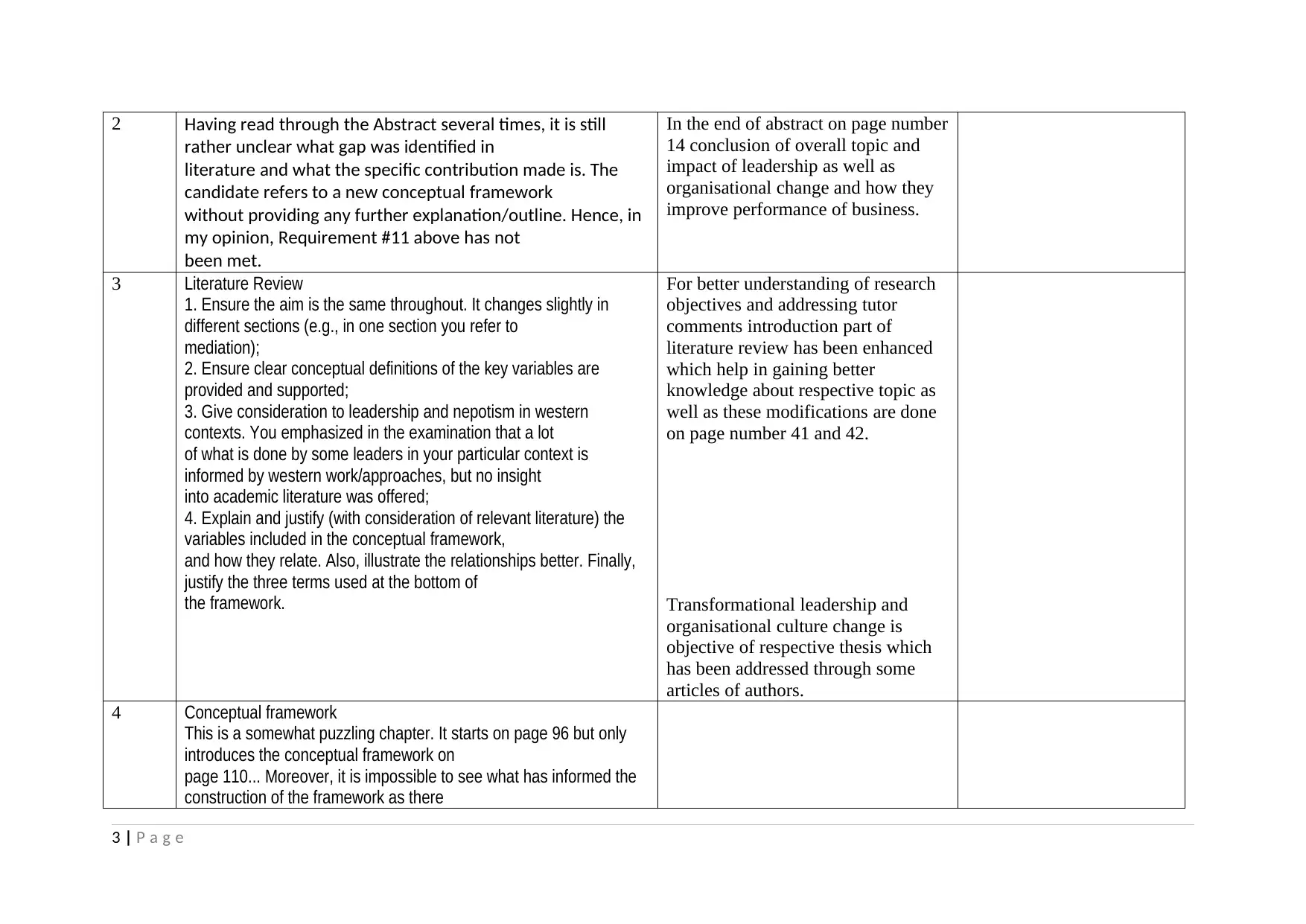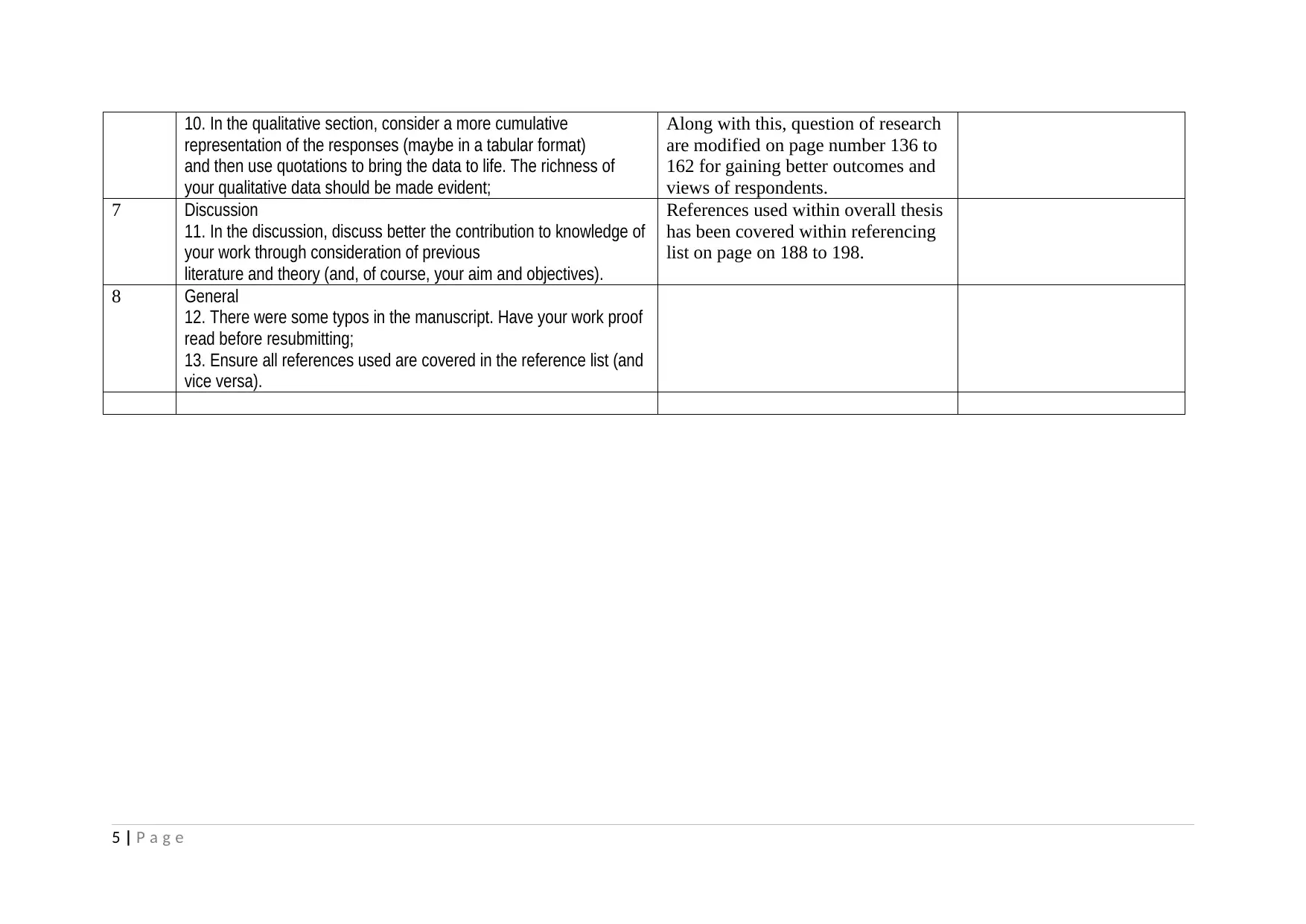Examining Leadership and Change: Royal Jordanian Airlines Case Study
VerifiedAdded on 2023/02/02
|5
|1276
|27
Report
AI Summary
This document presents a detailed response to examiners' requirements for a PhD thesis titled 'A critical conceptualisation of leadership and organisational change: a case study of the Royal Jordanian airlines'. The thesis, which investigates leadership styles and their impact on organizational cultural change and performance, receives critical feedback regarding clarity, focus, and the gap in literature. The response addresses concerns about the abstract, literature review, conceptual framework, research methods, findings, and discussion, offering revisions and enhancements to strengthen the thesis. Key areas of improvement include clarifying the aim, providing clear definitions, justifying variables in the conceptual framework, reworking research methods, and offering a more focused quantitative results section. The response also addresses ethical considerations and the contribution to knowledge, ensuring all references are correctly cited. The revised thesis aims to offer a more systematic, rigorous, and insightful analysis of leadership and organizational change within the context of Royal Jordanian Airlines.

RESPONSE DOCUMENT BASED ON EXAMINERS’ REQUIREMENTS
No
EXAMINERS’ REQUIREMENTS WITH ADDITIONAL COMMENTS
CANDIDATE’S RESPONSE TO THE EXAMINERS’ REQUIREMENTS.
LOCATION OF CORRECTION IN THE REVISED THESES
1 The thesis ‘A critical conceptualisation of leadership
and organisational change: a case study of the
Royal
Jordanian airlines‘ is in my view an interesting topic for a
PhD study (should the word ‘cultural’ be included
here between ‘organizational and ‘change’?). However, the
first sentence of the Abstract introduces the
purpose as “to investigate leadership style of the
top management executives including the Chief
Executive
Officer of Royal Jordanian airline to understand
the factors that influence organizational cultural
change
within the company”. Then on page 23 (Introduction)
the purpose is identified as “This study is about top
management including CEO leadership and its
linkage with organizational cultural change and
organizational performance.” On page 37
(Introduction) the research question has then been identified
as
“What is the role of organisational culture
change by the top leadership of the Royal
Jordanian airline in
order to improve organizational performance?”
These are not four ways of saying the same. Rather,
thedifferent statements presents unclarity and lack of focus. I
don’t automatically see the link between thesis
As per the given comment of tutor
Abstract has been modified as well as
its quality has been enhance. Because
it focusing more on the topic of thesis
i.e., a critical conceptualisation of
leadership and organizational change: the
case of royal Jordanian airline.
1 | P a g e
No
EXAMINERS’ REQUIREMENTS WITH ADDITIONAL COMMENTS
CANDIDATE’S RESPONSE TO THE EXAMINERS’ REQUIREMENTS.
LOCATION OF CORRECTION IN THE REVISED THESES
1 The thesis ‘A critical conceptualisation of leadership
and organisational change: a case study of the
Royal
Jordanian airlines‘ is in my view an interesting topic for a
PhD study (should the word ‘cultural’ be included
here between ‘organizational and ‘change’?). However, the
first sentence of the Abstract introduces the
purpose as “to investigate leadership style of the
top management executives including the Chief
Executive
Officer of Royal Jordanian airline to understand
the factors that influence organizational cultural
change
within the company”. Then on page 23 (Introduction)
the purpose is identified as “This study is about top
management including CEO leadership and its
linkage with organizational cultural change and
organizational performance.” On page 37
(Introduction) the research question has then been identified
as
“What is the role of organisational culture
change by the top leadership of the Royal
Jordanian airline in
order to improve organizational performance?”
These are not four ways of saying the same. Rather,
thedifferent statements presents unclarity and lack of focus. I
don’t automatically see the link between thesis
As per the given comment of tutor
Abstract has been modified as well as
its quality has been enhance. Because
it focusing more on the topic of thesis
i.e., a critical conceptualisation of
leadership and organizational change: the
case of royal Jordanian airline.
1 | P a g e
Paraphrase This Document
Need a fresh take? Get an instant paraphrase of this document with our AI Paraphraser

RESPONSE DOCUMENT BASED ON EXAMINERS’ REQUIREMENTS
No
EXAMINERS’ REQUIREMENTS WITH ADDITIONAL COMMENTS
CANDIDATE’S RESPONSE TO THE EXAMINERS’ REQUIREMENTS.
LOCATION OF CORRECTION IN THE REVISED THESES
title and purpose as identified in the Abstract and in the
Introduction. Hence, in my opinion, Requirement #
1 above has not been met.
Along with this, concept of leadership
and organisational changes are also
discussed for better understanding of
topic. These changes are marked on page
no. 13.
2 | P a g e
No
EXAMINERS’ REQUIREMENTS WITH ADDITIONAL COMMENTS
CANDIDATE’S RESPONSE TO THE EXAMINERS’ REQUIREMENTS.
LOCATION OF CORRECTION IN THE REVISED THESES
title and purpose as identified in the Abstract and in the
Introduction. Hence, in my opinion, Requirement #
1 above has not been met.
Along with this, concept of leadership
and organisational changes are also
discussed for better understanding of
topic. These changes are marked on page
no. 13.
2 | P a g e

2 Having read through the Abstract several times, it is still
rather unclear what gap was identified in
literature and what the specific contribution made is. The
candidate refers to a new conceptual framework
without providing any further explanation/outline. Hence, in
my opinion, Requirement #11 above has not
been met.
In the end of abstract on page number
14 conclusion of overall topic and
impact of leadership as well as
organisational change and how they
improve performance of business.
3 Literature Review
1. Ensure the aim is the same throughout. It changes slightly in
different sections (e.g., in one section you refer to
mediation);
2. Ensure clear conceptual definitions of the key variables are
provided and supported;
3. Give consideration to leadership and nepotism in western
contexts. You emphasized in the examination that a lot
of what is done by some leaders in your particular context is
informed by western work/approaches, but no insight
into academic literature was offered;
4. Explain and justify (with consideration of relevant literature) the
variables included in the conceptual framework,
and how they relate. Also, illustrate the relationships better. Finally,
justify the three terms used at the bottom of
the framework.
For better understanding of research
objectives and addressing tutor
comments introduction part of
literature review has been enhanced
which help in gaining better
knowledge about respective topic as
well as these modifications are done
on page number 41 and 42.
Transformational leadership and
organisational culture change is
objective of respective thesis which
has been addressed through some
articles of authors.
4 Conceptual framework
This is a somewhat puzzling chapter. It starts on page 96 but only
introduces the conceptual framework on
page 110... Moreover, it is impossible to see what has informed the
construction of the framework as there
3 | P a g e
rather unclear what gap was identified in
literature and what the specific contribution made is. The
candidate refers to a new conceptual framework
without providing any further explanation/outline. Hence, in
my opinion, Requirement #11 above has not
been met.
In the end of abstract on page number
14 conclusion of overall topic and
impact of leadership as well as
organisational change and how they
improve performance of business.
3 Literature Review
1. Ensure the aim is the same throughout. It changes slightly in
different sections (e.g., in one section you refer to
mediation);
2. Ensure clear conceptual definitions of the key variables are
provided and supported;
3. Give consideration to leadership and nepotism in western
contexts. You emphasized in the examination that a lot
of what is done by some leaders in your particular context is
informed by western work/approaches, but no insight
into academic literature was offered;
4. Explain and justify (with consideration of relevant literature) the
variables included in the conceptual framework,
and how they relate. Also, illustrate the relationships better. Finally,
justify the three terms used at the bottom of
the framework.
For better understanding of research
objectives and addressing tutor
comments introduction part of
literature review has been enhanced
which help in gaining better
knowledge about respective topic as
well as these modifications are done
on page number 41 and 42.
Transformational leadership and
organisational culture change is
objective of respective thesis which
has been addressed through some
articles of authors.
4 Conceptual framework
This is a somewhat puzzling chapter. It starts on page 96 but only
introduces the conceptual framework on
page 110... Moreover, it is impossible to see what has informed the
construction of the framework as there
3 | P a g e
⊘ This is a preview!⊘
Do you want full access?
Subscribe today to unlock all pages.

Trusted by 1+ million students worldwide

are no links to the literature review. In its current state, this chapter
and framework has little or no value.
5 Research Method
5. Rework the methods. You did describe a more systematic
approach during the examination than what is offered
currently in the thesis. Consequently, look at peer reviewed research
and how they set up multiple study papers
– then, use these to guide a method section that describes and
justifies, clearly, a systematic and rigorous
approach. For each study, the sample adopted, the collection tools
used, the analysis techniques utilized, and
the reason for representation should all be highlighted and justified;
6. Within the analysis section of the qualitative phase, when you tell
the reader more about how you developed
themes from the raw interview data, discuss also the influence of
bias, and the importance of reliability and validity
(through the concept of trustworthiness).
7. During the oral examination, you acknowledged that other
quantitative analyses were needed to address the aim
of the study. Consequently, revisit your analyses of the quantitative
data, offering insight into an analysis that is
more focused to help address your aim;
8. Consider the ethical issues with the approach you adopted. Within
this, discuss the potential issue of you being
an ‘insider’ within that organization. Due to you previously working in
the organization, and the fact that family
members have positions of influence in the organization, this is an
important discussion point
For addressing comments of tutor and
better understanding of research
methodology, research philosophy
has been discussed and which
methods will be use for conducting
research are mention on page number
111. there are mainly three research
philosophy i.e., positivism,
interpretivism and pragmatism are
discussed separately. In the end, on
page number 114 it has been
concluded that for conducting
research pragmatism research
philosophy has been used.
Experimental and explanatory
research design has been explained in
relation of respective thesis on page
number 116.
6 Findings
9. As per requirement 7, provide a more focused and relevant
quantitative results section that clearly addresses the
aim with more sophisticated analyses;
moreover, for better understanding of
qualitative research has been
explained in more detail and how it
help in conducting research.
and framework has little or no value.
5 Research Method
5. Rework the methods. You did describe a more systematic
approach during the examination than what is offered
currently in the thesis. Consequently, look at peer reviewed research
and how they set up multiple study papers
– then, use these to guide a method section that describes and
justifies, clearly, a systematic and rigorous
approach. For each study, the sample adopted, the collection tools
used, the analysis techniques utilized, and
the reason for representation should all be highlighted and justified;
6. Within the analysis section of the qualitative phase, when you tell
the reader more about how you developed
themes from the raw interview data, discuss also the influence of
bias, and the importance of reliability and validity
(through the concept of trustworthiness).
7. During the oral examination, you acknowledged that other
quantitative analyses were needed to address the aim
of the study. Consequently, revisit your analyses of the quantitative
data, offering insight into an analysis that is
more focused to help address your aim;
8. Consider the ethical issues with the approach you adopted. Within
this, discuss the potential issue of you being
an ‘insider’ within that organization. Due to you previously working in
the organization, and the fact that family
members have positions of influence in the organization, this is an
important discussion point
For addressing comments of tutor and
better understanding of research
methodology, research philosophy
has been discussed and which
methods will be use for conducting
research are mention on page number
111. there are mainly three research
philosophy i.e., positivism,
interpretivism and pragmatism are
discussed separately. In the end, on
page number 114 it has been
concluded that for conducting
research pragmatism research
philosophy has been used.
Experimental and explanatory
research design has been explained in
relation of respective thesis on page
number 116.
6 Findings
9. As per requirement 7, provide a more focused and relevant
quantitative results section that clearly addresses the
aim with more sophisticated analyses;
moreover, for better understanding of
qualitative research has been
explained in more detail and how it
help in conducting research.
Paraphrase This Document
Need a fresh take? Get an instant paraphrase of this document with our AI Paraphraser

10. In the qualitative section, consider a more cumulative
representation of the responses (maybe in a tabular format)
and then use quotations to bring the data to life. The richness of
your qualitative data should be made evident;
Along with this, question of research
are modified on page number 136 to
162 for gaining better outcomes and
views of respondents.
7 Discussion
11. In the discussion, discuss better the contribution to knowledge of
your work through consideration of previous
literature and theory (and, of course, your aim and objectives).
References used within overall thesis
has been covered within referencing
list on page on 188 to 198.
8 General
12. There were some typos in the manuscript. Have your work proof
read before resubmitting;
13. Ensure all references used are covered in the reference list (and
vice versa).
5 | P a g e
representation of the responses (maybe in a tabular format)
and then use quotations to bring the data to life. The richness of
your qualitative data should be made evident;
Along with this, question of research
are modified on page number 136 to
162 for gaining better outcomes and
views of respondents.
7 Discussion
11. In the discussion, discuss better the contribution to knowledge of
your work through consideration of previous
literature and theory (and, of course, your aim and objectives).
References used within overall thesis
has been covered within referencing
list on page on 188 to 198.
8 General
12. There were some typos in the manuscript. Have your work proof
read before resubmitting;
13. Ensure all references used are covered in the reference list (and
vice versa).
5 | P a g e
1 out of 5
Your All-in-One AI-Powered Toolkit for Academic Success.
+13062052269
info@desklib.com
Available 24*7 on WhatsApp / Email
![[object Object]](/_next/static/media/star-bottom.7253800d.svg)
Unlock your academic potential
Copyright © 2020–2025 A2Z Services. All Rights Reserved. Developed and managed by ZUCOL.